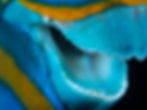Parrotfish: The Beach-Building, Coral-Saving, Mucus-Making Wonders of the Reef
- Tracy Gunn
- Jul 2
- 7 min read
Updated: Oct 22
In the Caribbean, we’re lucky to enjoy powdery white beaches that don’t scorch your feet, even on the hottest days. Our vibrant turquoise waters are the envy of the world, and Playa Norte in Isla Mujeres is a perfect example. But where does all this beauty come from? Believe it or not, much of it is thanks to a fish. A very special fish.
Meet the Caribbean parrotfish—reef grazers, beach builders, and surprise conservation heroes.

Why Caribbean Beaches Are Made of Parrotfish Sand?
Let’s start with a grain of sand.
Sand is defined by its size, not its composition. It’s anything coarser than silt and finer than gravel. As Rachel Carson once said, “In every curving beach, in every grain of sand, there is a story of the Earth.”


Some beaches, such as those in Florida, are the result of mineral erosion that has occurred over thousands of years. Tan beaches come from iron oxide, black beaches from volcanic lava rock, and Bermuda’s pink beaches? They’re made from crushed foraminifera, a single-celled organism with a shell.
However, in places dominated by coral reefs—such as Isla Mujeres—the story changes. One study in the Maldives found that up to 85% of the sand on certain islands was produced by one unlikely source: the parrotfish.
Sand Fact: One Parrotfish Can Produce Up to 450 kg (1,000 lbs) of Sand Per Year!
That’s roughly the weight of a baby grand piano.

Parrotfish are relentless grazers. They spend up to 90% of their day munching on coral, scraping off the calcium carbonate skeleton, soft-bodied coral polyps, and zooxanthellae(symbiotic algae). The indigestible bits? They’re ground down in the parrotfish’s gut and excreted as soft, white sand.
This process not only creates the beaches we love—it helps build the very structure of the reef, acting as a filler for the physical structure, supporting the coral's skeletons.
Why Is Caribbean Water So Blue?
Why are Caribbean waters that dreamy blue?
As NASA oceanographer Gene Feldman explains, “The water is this beautiful turquoise because the bottom is either white sand or white rocks. Light comes down, blue light gets through, hits the bottom, and reflects back up—creating that glowing blue.

Why Doesn’t the Sand Burn Your Feet? Thank the Halimeda Algae.

Besides parrotfish, a green algae called Halimeda plays a role in beach building. When Halimeda dies, its calcium segments turn white and break down into a powder that blends with sand. Up to 30% of beach sand in reef areas may come from Halimeda.
This powdery texture also reflects sunlight, keeping the sand cooler beneath your feet.
A Beak Built for Reef Work

Parrotfish (from the Scaridae family) get their name from their beak-like jaws, formed from approximately 1,000 teeth arranged in 15 rows and cemented together to form the beak-like structure, which are constantly being replaced as they wear out and fall to the ocean floor. These teeth are made of fluorapatite, a material harder than copper, silver, and even gold. They can withstand up to 530 tons of pressure per square inch—about the weight of 88 elephants, according to Dr Pupa Gilbert. Parrotfish can graze all day because of these powerful beaks, from which they get their name, and you can often hear them crunching coral during your dives.

But Is All That Coral-Eating Good for the Reef? Absolutely.
Parrotfish and other herbivores play a critical role in maintaining healthy coral reefs. Algae constantly compete with coral for sunlight and space, and when left unchecked, they can smother entire colonies, especially after bleaching events when corals are already vulnerable. Grazers like parrotfish act as the reef’s natural lawnmowers, keeping algal growth under control and clearing room for coral larvae to settle and grow.
In fact, the decline of these grazers—due to overfishing, bycatch, and disease—has been directly linked to the rise of algal dominance and a sharp drop in reef biodiversity. Since the 1970s, Caribbean coral cover has declined by nearly 50%, not just because of climate change, but largely because we’ve lost these essential algae-eaters.
The impact of protecting parrotfish is clear: in marine reserves like Manchones National Park, where these fish are thriving, coral coverage is two to three times higher than in unprotected areas. Their constant grazing doesn’t just help reefs survive—it gives them a fighting chance to recover and thrive.
The decline of parrotfish and other herbivores has been directly linked to algal dominance and the loss of biodiversity across Caribbean reefs. That’s why parrotfish are considered a keystone species—remove them, and the whole ecosystem begins to unravel.
Mucus Sleeping Bags and Gender-Bending Fish: The Weird and Wonderful Parrotfish
What else makes them so interesting (besides their bowel movements)? Well, they build sleeping bags out of mucus, for a start. WHAT???
Parrotfish are heavy sleepers. And I mean heavy. They are capable of sleeping for up to 10 hours at a time. I guess all that non-stop eating can tire you out. This is a long time for a marine animal to remain unprotected.
Parrotfish have glands behind their gills that secrete mucus that slowly emerges from the mouth of the parrotfish over the space of about an hour. This transparent cocoon completely encases the fish. It is speculated that this covers the scent of the fish, protecting it from predation and that it might also protect it from parasitic isopods. It can also serve as an early warning system if a predator brushes against it, and can even protect the fish from the sun's UV rays. When the fish wakes, it just swims out and creates one next time it is tired.

The Gender-Bending Sex Lives of Parrotfish
They also have one of the most fascinating sex lives in the animal kingdom.
Most parrotfish start life as females. Some stay that way, but others later transform into males—a process known as protogynous hermaphroditism. When a dominant female changes sex, she also changes colour and becomes a secondary male, taking over the harem and fertilising all the eggs.
The males you see guarding harems of smaller, duller females? They’re usually former females. This sexual dimorphism—where males and females look different—is especially striking in parrotfish. As females mature, the more dominant ones will often challenge the harem leader, change sex, and take over the group.
There are also a few primary males—parrotfish born male from the start—but they’re the exception. And here's the twist: even secondary males can sometimes change back into females.
Because why not? Nature is wild.
Caribbean Coral Reefs and the Future of Parrotfish
The Caribbean is home to 9% of the world’s coral reefs, spread across 38 nations. These reefs generate over $3 billion annually and provide vital coastal protection, including storm and hurricane protection.
But they’re under threat.
"Parrotfish populations, which are crucial to the very survival of coral reefs, are being destroyed despite their enormous economic and ecological value,” warns Jerker Tamelander of the UNEP Coral Reef Unit.
What Can You Do to Help?
Don’t eat parrotfish.
Support local marine parks and protected areas.
Say no to seafood caught using destructive methods.
Educate others about reef conservation and the importance of keystone species.
Choose eco-conscious dive operators and tours.
As lionfish and overfishing threaten parrotfish populations, every decision we make matters.

Parrotfish: The Keystone Species Saving Coral Reefs
With their rainbow scales, industrial-strength teeth, quirky behaviours, and outsized impact on the reef, parrotfish are true marine marvels. They build our beaches, clean our reefs, and remind us how interconnected life underwater really is.
If we act now and change our consumption choices, put in protective measures against overfishing and bycatch, and do everything we can to protect this species, our reefs not only have a chance to survive but also recover.
By protecting them, we protect everything.
Let’s do better—for the fish that poop out beaches.
🌿 Dive into the Parrotfish’s World at Manchones Reef
Discover vibrant coral gardens, curious parrotfish, and the vital role they play in reef health. Join us for an unforgettable eco-conscious dive in Isla Mujeres.

Tracy Gunn is the founder and owner of Pocna Dive Center on Isla Mujeres, Mexico. A former banker turned adventurer, Tracy left a decade-long corporate career to pursue her passion for diving and island life. With over 35 years of diving experience and 24 years of living on Isla Mujeres, she now serves as a PADI Course Director, training the next generation of divers at her dive school. When she’s not underwater, Tracy shares her love for the island and the ocean through engaging blogs about diving, marine life, and the culture of Isla Mujeres.
Interested in reading more from this author?
Blogs about Isla Mujeres, Mexico, and Recreational Scuba Diving: click here
Blogs about Instructor Development Courses and Professional Scuba Diving: click here
G. (2017, November 15). X-Rays Reveal the Biting Truth About Parrotfish Teeth. News Center. https://newscenter.lbl.gov/2017/11/15/xrays-reveal-biting-truth-about-parrotfish-teeth/
Gallagher, A. (2018, May 7). Tough Teeth and Parrotfish Poop. Smithsonian Ocean. https://ocean.si.edu/ocean-life/fish/tough-teeth-and-parrotfish-poop
Perry, C., Kench, P., O'Leary, M., Morgan, K., & Januchowski-Hartley, F. (2015). Linking reef ecology to island building: Parrotfish identified as major producers of island-building sediment in the Maldives. Geology, 43(6), 503–506. https://doi.org/10.1130/g36623.1
Ronson, J. (2017, July 17). Actually, Some Sandy Beaches Are Made of Parrotfish Poop. Inverse. https://www.inverse.com/article/34220-chasing-coral-netflix-parrotfish-poop-sand-beach
From despair to repair: Dramatic decline of Caribbean corals can be. (2020, February 17). IUCN. https://www.iucn.org/content/despair-repair-dramatic-decline-caribbean-corals-can-be-reversed
School, S. S. (2020, June 30). Parrotfish and Mucus Cocoons. Sanibel Sea School. https://www.sanibelseaschool.org/experience-blog/2020/6/30/parrotfish-and-mucus-cocoons#:%7E:text=Mucus%20is%20secreted%20from%20glands,of%20an%20hour%20to%20complete.
Pavlowich, T., Webster, D. G., Kapuscinski, A. R., Deming, J. W., & Keister, J. E. (2018, October 8). Leveraging sex change in parrotfish to manage fished populations. University of California Press. https://online.ucpress.edu/elementa/article/doi/10.1525/elementa.318/112842/Leveraging-sex-change-in-parrotfish-to-manage
Baker, H. (2020, November 4). Parrotfish: the gender fluid narcoleptics that poop out beaches. Marine Madness. https://marinemadness.blog/2020/02/04/parrotfish-the-gender-fluid-narcoleptics-that-poop-out-beaches/
Onion, A. (2021, June 12). Why Is the Ocean Different Colors in Different Places? HowStuffWorks. https://science.howstuffworks.com/environmental/earth/oceanography/why-is-ocean-different-colors-different-places.htm
George Stoyle - Conserving Parrotfish as Keystone Species; Integrating Social and Ecological Approaches to Prevent Macroalgal Dominance on Caribbean Coral Reefs - The Rufford Foundation. (2021). The Ruffor Foundation. https://www.rufford.org/projects/george-stoyle/conserving-parrotfish-as-keystone-species-integrating-social-and-ecological-approaches-to-prevent-macroalgal-dominance-on-caribbean-coral-reefs/#:%7E:text=Parrotfish%20are%20a%20keystone%20species,function%20as%20algal%20consumers%20decreases.
Mimic, O. (2020, July 6). Particulars About Parrotfish. Ocean Mimic. https://ocean-mimic.com/parrotfish/
Status and trends of Caribbean coral reefs : 1970–2012. (2020, March 9). IUCN. https://www.iucn.org/content/status-and-trends-caribbean-coral-reefs-1970-2012





